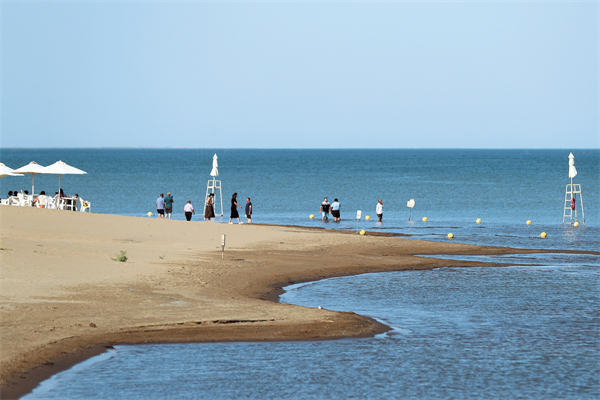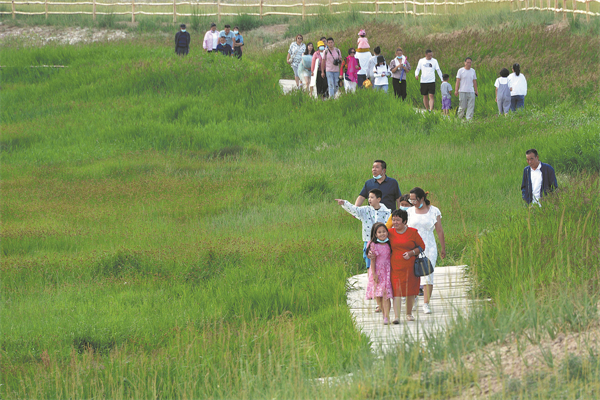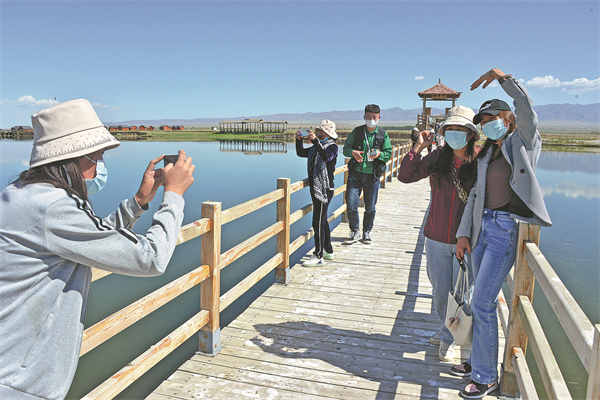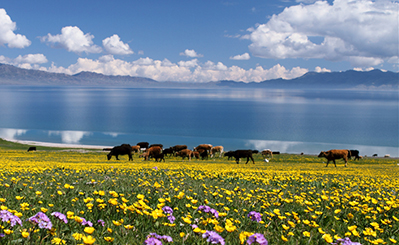Life looks up for villagers in Xinjiang
Water better used, poverty eradicated, services improved
During the late 1980s, the Hami River, the main waterway in the east of the Xinjiang Uygur autonomous region, nearly dried up.
However, in recent years, wild birds such as egrets have been seen feeding and resting along the Hami, which is known as the "Mother River" of Hami prefecture. The birds have become a scenic attraction in the area.
Since 1998, the authorities in the prefecture have supplied water to the river to improve the environment. In 2019, the Hami River Ecological Restoration Project was launched by the authorities, who also established the Hami River National Wetland Park.
Song Zhanshi, director of the management office at the wetland park, said that by renovating more than 10,000 shantytowns near the river, preserving the original water system and adding plants, the greening rate along the waterway has risen from 18 percent to 78 percent.
The park, which stretches for about 42 kilometers north to south, is some 400 meters wide. It features pavilions by the riverside against a backdrop of gently flowing water, flowers, grass and old trees.
Abdu Kader, 84, who lives in Hami's Yizhou district, said, "It is beautiful here, and I feel very happy walking in the area every day."
The Hami River National Wetland Park attracts a wide range of visitors for leisure, entertainment, fitness activities, and simply to enjoy the scenery.
Hami has scant rainfall, and more than 70 percent of its land is desert and mountains.
The prefecture is one of the most water-deficient areas of Xinjiang, with the Hami River acting as a vital lifeline at the southern foot of the Tianshan Mountains. The river is sourced mainly by melting snow on the mountains, and protecting water sources and using water more efficiently are crucial for Hami's socioeconomic development and people's livelihoods.
Despite its lack of water, Hami boasts abundant wind and solar resources. It has become a national comprehensive energy hub, mainly consisting of wind power bases and photovoltaic bases. New energy bases are planned for the area.
However, the intermittent nature and volatile characteristics of wind power and photovoltaic power pose challenges to the safe and stable operation of the grid.

The waters in Xinjiang Uygur autonomous region provide habitats for the coexistence of humans, animals and other forms of wildlife. Photo/Wang Zhuangfei]
Xu Hongwei, general manager and deputy Party secretary of State Grid Xinyuan Xinjiang Hami Pumped Storage Co, said that as a result of these factors, work has started on the Hami Pumped Storage Power Station.
"For the grid, a pumped storage power station acts as a 'superpower bank'. When the grid faces high demand, the power station releases water from the reservoir to generate electricity and ensure a stable supply," Xu said.
"During periods of low demand, the power station uses off-peak electricity to pump and store energy. This unique advantage promotes the consumption of new energy, effectively mitigates fluctuations in generating this energy, reduces wind and solar power stoppages, improves the efficiency of generating new energy, and maintains the stable operation of the power grid."
The power station is being built alongside the Sandaogou River in Tianshan township, Yizhou district, Hami. As water will be introduced downstream into the Shichengzi Reservoir, this poses challenges for water protection and maintaining high environmental standards.
"Since the water source for the power station is Hami's primary production and domestic water source, the construction process involves disposing of industrial and domestic wastewater to the highest standards, with additional investment exceeding 100 million yuan ($13.6 million)," Xu said.
Yan Kai, deputy director of the Hami Development and Reform Commission, said, "We are also employing local villagers and herdsmen, promoting grassland restoration, and striving to achieve the green construction goal of protecting source water quality for the extremely arid Hami region.
"Since the project was implemented, vegetation near the power station has increased and improved significantly, and the groundwater level has also risen to some extent."
The power station, which is scheduled to be fully operational in 2028, has a designed annual generation capacity of nearly 1.37 billion kilowatt-hours. This capacity can reduce coal consumption by about 239,000 metric tons and carbon dioxide emissions by 596,000 tons annually, contributing to carbon peak and carbon neutrality goals being achieved.
Costs reduced
Located 160 km north of the East Tianshan Mountains, Naomao Lake town in Yiwu county, Xinjiang, nestles deep in the vast Gobi Desert, sharing borders with Mongolia to the north and east.
The area has abundant sunlight, a dry climate, and a vast difference between daytime and nighttime temperatures. It is known for a forest that covers some 31,333 hectares and for the production of high-quality Hami melons, which are recognized domestically and internationally.
The late-maturing Hami melon cultivation area covers about 2,667 hectares, yielding fruit of exceptional shape, color, texture and high commercial value.
Wei Bin, 34, a villager with nearly 20 hectares of melon fields, said: "We use sheep manure as organic fertilizer in our fields, and the soil's high nutrition levels result in exceptional Hami melons. We earn an average income of about 4,000 yuan from every 0.066 of a hectare, and this year's crop of melons has already been ordered by merchants from various areas."
By promoting the use of membrane drip irrigation systems and using irrigation methods controlled by a smartphone app, overall water costs have been reduced by 30 percent. In addition, increasing the frequency of irrigation while reducing the amount of water used for this purpose has improved the crispness and color of the melons.
Zhang Mingsheng, a member of the Naomao Lake Town Party Committee, said, "Naomao Lake-branded Hami melons are exported to countries such as Vietnam through e-commerce channels.
"The melon industry in Hami will develop melon wine and freeze-dried products, improve the industry's market-oriented management, stabilize prices, and increase melon farmers' incomes."
The Hami melon cultivation base, which completed the transition to membrane drip irrigation in 2001, has saved 175 million cubic meters of water over 22 years, equivalent to the total water volume of Tianchi in the Tianshan Mountains. This initiative not only ensures the groundwater level remains stable, but also provides vital support for development of the coal and chemical industries in Yiwu.
In the first half of this year, Yiwu county's GDP reached 11.52 billion yuan, a year-on-year rise of 31 percent.

Visitors enjoy the wetland in Barkol Kazakh autonomous county, Hami, Xinjiang. [Photo/seexinjiang.com]
Mountain divide
Hami is divided into northern and southern areas by the Tianshan Mountains. In the southern area, fertile land and the Gobi Desert converge, while the northern area features forests, grasslands, snowcapped mountains and glaciers. As a result, Hami is a microcosm of Xinjiang, as it can experience four seasons in a single day and different weather conditions within a 16-kilometer radius.
Barkol Kazakh autonomous county in the north, located next to Yiwu, is home to a landscape rich in snow-capped mountains, forests, grasslands and lakes. Viewed from the Gaojiahu Wetland Scenic Area, the distant Tianshan Mountains are covered with snow and ice, while rivers and lakes dot the grassland. This ecosystem not only serves as a habitat for birds such as gray geese and ruddy shelducks, but also attracts tourists from across China.
The scenic area, which is located in the northern part of Shirenzi township, Barkol county, and covers 59,400 hectares, is one of the country's most important wetlands.
Poverty that existed in the area more than a decade ago, when there was dust on sunny days and deep mud when it rained, has long disappeared.
Bumpy and muddy roads have been transformed into smooth belts of asphalt, and low-rise, dilapidated adobe houses replaced by comfortable, well-equipped rural-style homes. Villagers not only enjoy a pleasant environment, but also increased employment opportunities.
Since 2021, with an investment of 31 million yuan from Henan province as part of its assistance to Xinjiang, construction projects such as sightseeing corridors, wooden walkways, and water recreational facilities have been implemented in the Gaojiahu Wetland Scenic Area.
These projects have comprehensively expanded and improved infrastructure in the area, significantly enhanced living conditions for farmers and herdsmen, and improved the quality of tourist services.

Visitors pose at the Gaojiahu Wetland Scenic Area in Barkol Kazakh autonomous county, Hami, Xinjiang. [Photo/seexinjiang.com]
In addition, more than 300 local jobs have been created, and employment indirectly generated for over 1,200 people — consolidating the achievements made in poverty alleviation, and serving as an ideal example of rural revitalization.
Jiang Xiaoliang, secretary of the Party Group and deputy director of the Cultural, Sports, Broadcasting, Television and Tourism Bureau in Barkol, said, "The assistance received from Henan has greatly broadened our construction ideas.
"Fish ponds in this area used to be surrounded by saline-alkaline soil, but now we have built accommodations from which to view the stars at night, with the first floor used for lodging and the second floor for barbecues.
"French windows offer views of the beautiful lake, which are very popular among tourists. Last year, the scenic area received nearly 700,000 visitors, each spending an average of 268 yuan. Tourism income exceeded 200 million yuan, and locals are now earning more."
Ma Xianghui, deputy secretary of Barkol County CPC Committee and commander of Henan Assistance to Xinjiang Command in Barkol County, said, "For the next step, we will better implement the concept of 'green mountains and clear waters are as valuable as mountains of gold and silver', protect the environment of Gaojia Lake, improve the level of tourist services, attract more visitors, and help villagers sustainably increase their income."
 Attractions
Attractions Dining
Dining Culture
Culture